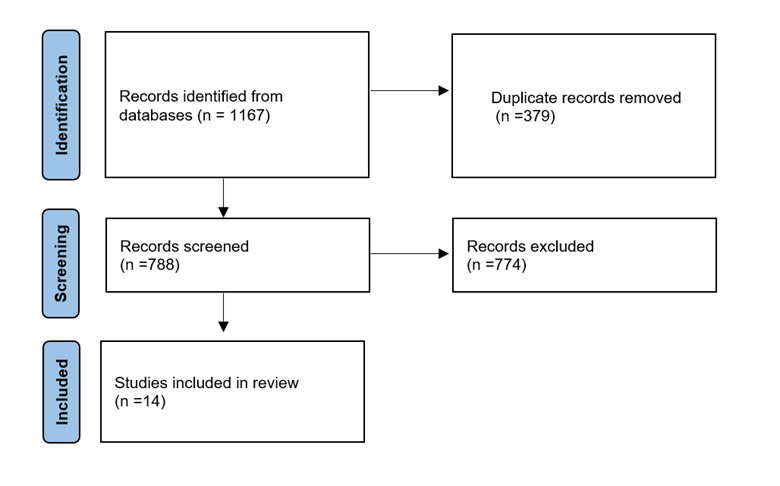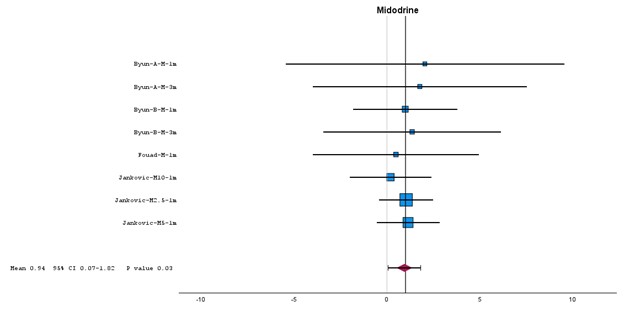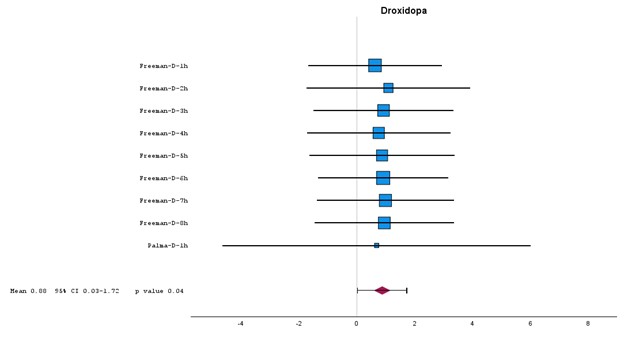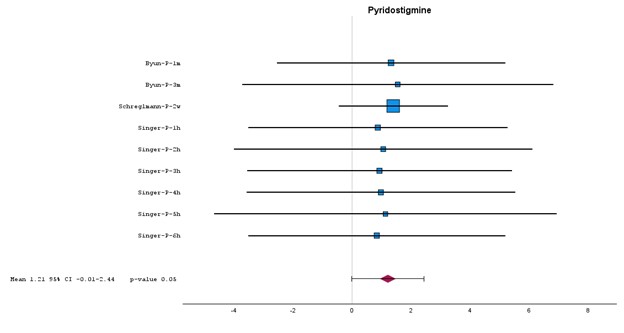Category: Parkinson's Disease: Non-Motor Symptoms
Objective: To review potential effect of common orthostatic hypotension medications on orthostatic ratio
Background: Orthostatic ratio, defined as change in heartrate over change in systolic blood pressure via orthostatic blood pressure measurement, has been shown to be a diagnostic indicator for neurogenic orthostatic hypotension if <0.5 [1]. It is unclear how the ratio is modulated by common orthostatic hypotension treatments.
Method: A systemic review was conducted via PubMed, Embase, and Web of Science, following PRISMA protocol with search terms including orthostatic ratio, neurogenic orthostatic hypotension, and treatment [Figure 1]. Inclusion criteria include relevant English articles, with reported orthostatic ratio, orthostatic blood pressure or heart rate data. Exclusion criteria were irrelevant subject or format articles including non-English language. 1167 citations were identified and imported to the reference manager website Ryyan.com for screening. Two independent reviewers determined that 14 studies met our inclusion criteria and were included for meta-analysis [2-15]. No explicit orthostatic ratio was found, however. As the result orthostatic ratio was calculated using heart rate and systolic blood pressure data instead. For each treatment regimen, an odd ratio was calculated comparing the ratio changes before and after treatment. Error propagation calculator was employed where necessary. Statistics, including graphic presentation, was done using IBM SLSS software.
Results: No individual treatment shows any significant changes to orthostatic ratio in subgroup analysis including midodrine (odd ratio 0.94, CI 0.07-1.92, p 0.03), droxidopa (odd ratio 0.88, confidence interval 0.03-1.72, p 0.03), or pyridostigmine (odd ratio 1.21, CI 0.01-2.44, p 0.05).
Conclusion: Orthostatic ratio was not significantly affected by common treatments for orthostatic hypotension, which indicates that the ratio can be a reliable diagnosis indicator for neurogenic orthostatic hypotension regardless of medical therapy.
Figure 1
Figure 2
Figure 3
Figure 4
References: [1] Norcliffe-Kaufmann L, Kaufmann H, Palma JA, et al. Orthostatic heart rate changes in patients with autonomic failure caused by neurodegenerative synucleinopathies. Ann Neurol. 2018;83(3):522-531. doi:10.1002/ana.25170
[2] Byun JI, Kim DY, Moon J, et al. Efficacy of atomoxetine versus midodrine for neurogenic orthostatic hypotension [published correction appears in Ann Clin Transl Neurol. 2020 Mar;7(3):402]. Ann Clin Transl Neurol. 2020;7(1):112-120. doi:10.1002/acn3.50968
[3] Byun JI, Moon J, Kim DY, et al. Efficacy of single or combined midodrine and pyridostigmine in orthostatic hypotension. Neurology. 2017;89(10):1078-1086. doi:10.1212/WNL.0000000000004340
[4] Fouad-Tarazi FM, Okabe M, Goren H. Alpha sympathomimetic treatment of autonomic insufficiency with orthostatic hypotension. Am J Med. 1995;99(6):604-610. doi:10.1016/s0002-9343(99)80246-0
[5] Freeman R, Landsberg L, Young J. The treatment of neurogenic orthostatic hypotension with 3,4-DL-threo-dihydroxyphenylserine: a randomized, placebo-controlled, crossover trial. Neurology. 1999;53(9):2151-2157. doi:10.1212/wnl.53.9.2151
[6] Goldstein DS, Sewell L, Holmes C, Pechnik S, Diedrich A, Robertson D. Temporary elimination of orthostatic hypotension by norepinephrine infusion. Clin Auton Res. 2012;22(6):303-306. doi:10.1007/s10286-012-0176-4
[7] J Jankovic J, Gilden JL, Hiner BC, et al. Neurogenic orthostatic hypotension: a double-blind, placebo-controlled study with midodrine. Am J Med. 1993;95(1):38-48. doi:10.1016/0002-9343(93)90230-m
[8] Okamoto LE, Shibao CA, Gamboa A, et al. Synergistic Pressor Effect of Atomoxetine and Pyridostigmine in Patients With Neurogenic Orthostatic Hypotension. Hypertension. 2019;73(1):235-241. doi:10.1161/HYPERTENSIONAHA.118.11790
[9] Palma JA, Norcliffe-Kaufmann L, Martinez J, Kaufmann H. Supine plasma NE predicts the pressor response to droxidopa in neurogenic orthostatic hypotension. Neurology. 2018;91(16):e1539-e1544. doi:10.1212/WNL.0000000000006369
[10] Schreglmann SR, Büchele F, Sommerauer M, et al. Pyridostigmine bromide versus fludrocortisone in the treatment of orthostatic hypotension in Parkinson’s disease – a randomized controlled trial. Eur J Neurol. 2017;24(4):545-551. doi:10.1111/ene.13260
[11] Singer W, Opfer-Gehrking TL, McPhee BR, Hilz MJ, Bharucha AE, Low PA. Acetylcholinesterase inhibition: a novel approach in the treatment of neurogenic orthostatic hypotension. J Neurol Neurosurg Psychiatry. 2003;74(9):1294-1298. doi:10.1136/jnnp.74.9.1294
[12] Singer W, Sandroni P, Opfer-Gehrking TL, et al. Pyridostigmine treatment trial in neurogenic orthostatic hypotension. Arch Neurol. 2006;63(4):513-518. doi:10.1001/archneur.63.4.noc50340
[13] Singer W, Opfer-Gehrking TL, McPhee BR, Hilz MJ, Bharucha AE, Low PA. Acetylcholinesterase inhibition: a novel approach in the treatment of neurogenic orthostatic hypotension. J Neurol Neurosurg Psychiatry. 2003;74(9):1294-1298. doi:10.1136/jnnp.74.9.1294
[14] van Lieshout JJ, ten Harkel AD, Wieling W. Fludrocortisone and sleeping in the head-up position limit the postural decrease in cardiac output in autonomic failure. Clin Auton Res. 2000;10(1):35-42. doi:10.1007/BF02291388
[15] Z’Graggen WJ, Hess CW, Humm AM. Acute fluid ingestion in the treatment of orthostatic intolerance – important implications for daily practice. Eur J Neurol. 2010;17(11):1370-1376. doi:10.1111/j.1468-1331.2010.03030.x
To cite this abstract in AMA style:
V. Pham, M. Rashid, B. Kung, S. Hossain. Effect of Orthostatic Hypotension Medications on Orthostatic Ratio: A Systemic Review and Meta-Analysis [abstract]. Mov Disord. 2024; 39 (suppl 1). https://www.mdsabstracts.org/abstract/effect-of-orthostatic-hypotension-medications-on-orthostatic-ratio-a-systemic-review-and-meta-analysis/. Accessed April 18, 2025.« Back to 2024 International Congress
MDS Abstracts - https://www.mdsabstracts.org/abstract/effect-of-orthostatic-hypotension-medications-on-orthostatic-ratio-a-systemic-review-and-meta-analysis/




